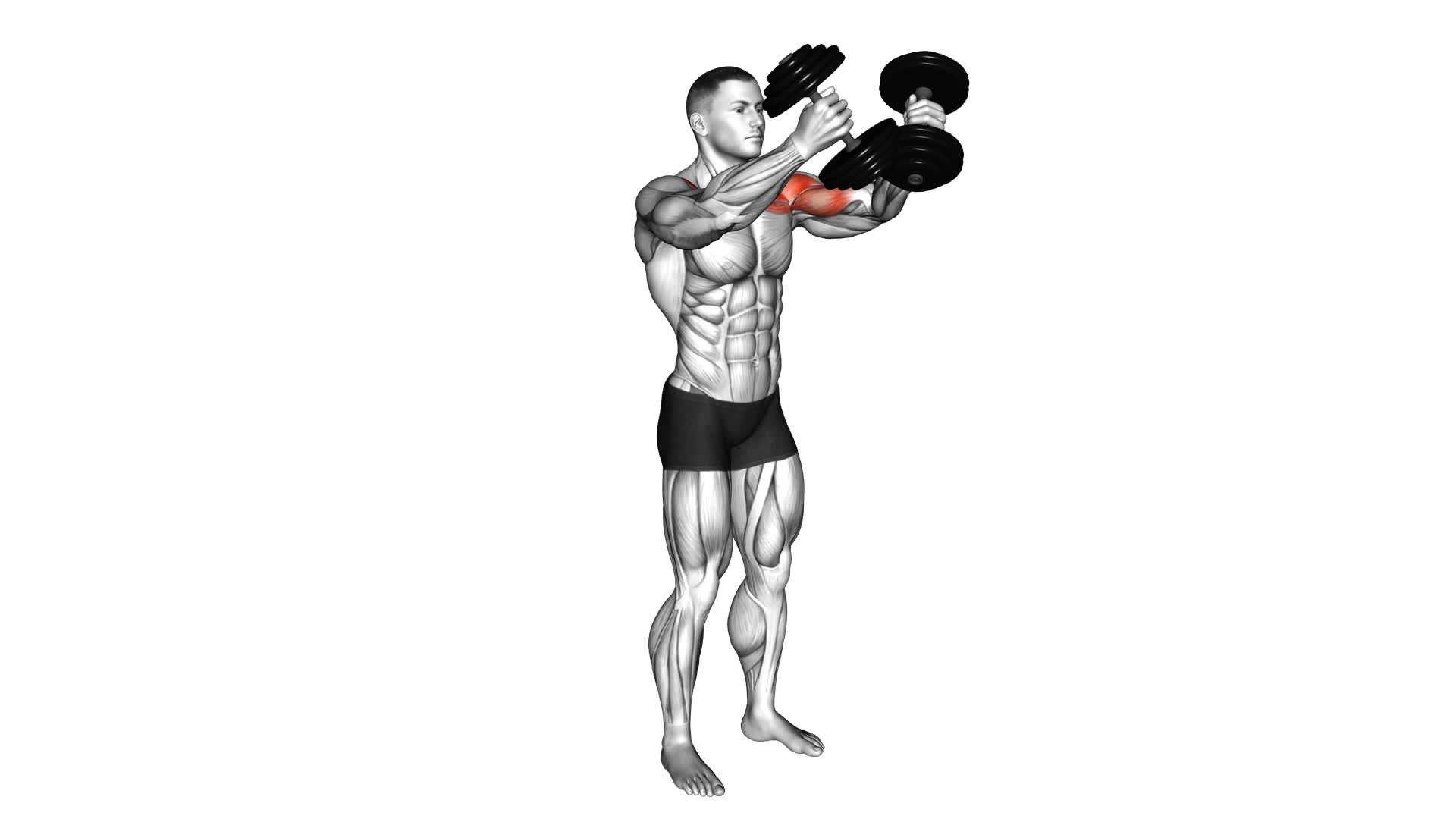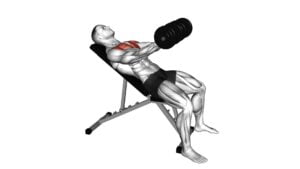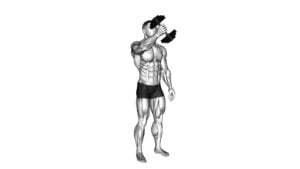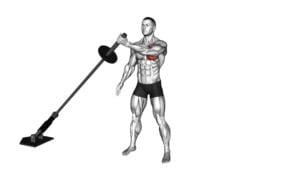Dumbbell Low Fly – Video Exercise Guide & Tips

Looking to tone your chest muscles? Check out this quick and effective exercise guide for the dumbbell low fly.
Watch This Exercise Video
In this video, you'll learn the proper form and technique to maximize your results. Avoid common mistakes and discover tips for increasing the intensity of this exercise.
With variations and modifications available, you can easily incorporate the dumbbell low fly into your workout routine.
Get ready to see and feel the difference!
Key Takeaways
- Dumbbell Low Fly targets the pectoralis major and minor muscles in the chest
- Proper form and technique are important to engage the chest and shoulder muscles effectively
- Common mistakes to avoid include dropping the dumbbells too low and flaring the elbows outwards
- Increasing intensity and difficulty can be achieved by using heavier weights and trying advanced modifications like performing the exercise on an unstable surface.
Benefits of the Dumbbell Low Fly
You can achieve a variety of benefits from incorporating the dumbbell low fly exercise into your workout routine.
This exercise primarily targets the muscles in your chest, specifically the pectoralis major and minor. By performing the dumbbell low fly, you can effectively strengthen and tone your chest muscles, leading to improved upper body strength and appearance.
One of the key benefits of this exercise is that it helps to enhance your overall chest development. The low fly motion targets the lower portion of your chest, which is often neglected in traditional chest exercises like push-ups or bench presses. By specifically targeting this area, you can achieve a more balanced and defined chest.
Additionally, the dumbbell low fly also helps to improve your shoulder stability and flexibility. As you bring the dumbbells down towards your sides, you engage your shoulder muscles, promoting better posture and reducing the risk of shoulder injuries.
To perform the dumbbell low fly, start by lying on a flat bench with a dumbbell in each hand. Slowly lower the weights out to the sides, keeping your elbows slightly bent, and then bring them back up to the starting position. Remember to maintain proper form and control throughout the exercise to maximize its benefits.
Incorporating the dumbbell low fly into your workout routine can provide you with a range of benefits, including improved chest development, enhanced shoulder stability, and increased upper body strength. Make sure to follow the proper exercise technique to achieve the best results.
Proper Form and Technique for the Dumbbell Low Fly
To ensure proper form and technique for the dumbbell low fly exercise, it's important to focus on maintaining control and stability throughout the movement. Here are three key tips to help you perform the exercise effectively:
- Start with the right weight: Choose dumbbells that challenge you without compromising your form. Too heavy of a weight can lead to improper technique and potential injury, while a weight that's too light may not provide enough resistance to effectively target the muscles.
- Maintain a slight bend in your elbows: Keeping a soft bend in your elbows throughout the movement helps to engage the muscles in your chest and shoulders. Avoid fully extending your arms, as this can put unnecessary stress on your joints.
- Control the motion: Slowly lower the weights out to the sides, keeping them in line with your shoulders. Focus on engaging your chest muscles as you bring the weights back up to the starting position. Avoid swinging or using momentum to lift the weights, as this takes away from the effectiveness of the exercise.
Common Mistakes to Avoid During the Dumbbell Low Fly
To avoid injury and maximize the effectiveness of your dumbbell low fly, it's crucial to maintain proper form.
One common mistake to avoid is incorrect alignment, which can lead to strain on your shoulders and back.
Remember to keep your elbows slightly bent and your chest lifted throughout the exercise to ensure optimal results.
Incorrect Form Risks Injury
During the Dumbbell Low Fly exercise, improper form can lead to potential injuries. It's crucial to maintain the correct technique to minimize the risks of incorrect form and ensure a safe workout. Here are three common mistakes to avoid:
- Dropping the dumbbells too low: Going too low can strain your shoulder joints and increase the risk of injury. Keep the dumbbells at a level where you feel a stretch in your chest muscles without any discomfort or pain.
- Flaring your elbows outwards: Allowing your elbows to flare out puts excessive stress on your shoulders. Keep your elbows slightly bent and close to your body throughout the exercise to maintain proper alignment.
- Using excessive weight: Lifting more weight than you can handle can compromise your form and increase the likelihood of injury. Start with lighter weights and gradually increase as your strength improves.
By avoiding these common mistakes and focusing on proper technique, you can prevent injuries and maximize the benefits of the Dumbbell Low Fly exercise.
Now, let's move on to the next section, where we'll discuss how proper alignment prevents strain.
Proper Alignment Prevents Strain
Maintain proper alignment to prevent strain while performing the Dumbbell Low Fly exercise.
Proper alignment is crucial in order to avoid putting unnecessary stress on your muscles and joints. To prevent strain, start by standing with your feet shoulder-width apart and your knees slightly bent. Keep your back straight and engage your core muscles throughout the exercise.
When holding the dumbbells, make sure your wrists are in a neutral position, and your elbows are slightly bent. As you lower the dumbbells, avoid letting your shoulders roll forward or rounding your back. Instead, keep your chest lifted and your shoulder blades squeezed together.
Tips for Increasing Intensity and Difficulty
If you're looking to challenge yourself and take your dumbbell low fly exercise to the next level, there are several ways you can increase intensity and difficulty. Here are three tips to help you achieve that:
- Increase the resistance: One of the most straightforward ways to make the dumbbell low fly more challenging is by using heavier weights. Gradually increase the weight of the dumbbells you're using to put more stress on your chest muscles. This will force them to work harder and promote muscle growth.
- Try advanced modifications: Once you've mastered the basic form of the dumbbell low fly, you can incorporate advanced modifications to increase the difficulty. For instance, you can perform the exercise on an unstable surface like a stability ball or BOSU ball. This will engage your core muscles and require more stability and control.
- Slow down the tempo: Slowing down the tempo of your reps can significantly increase the intensity of the exercise. Focus on maintaining control throughout the movement, and perform the exercise at a slower pace. This will increase time under tension, making your muscles work harder and leading to greater gains.
By implementing these tips, you can take your dumbbell low fly exercise to new heights of intensity and difficulty.
Now, let's delve into the various variations and modifications of the dumbbell low fly.
Variations and Modifications of the Dumbbell Low Fly
Now let's explore some variations and modifications of the dumbbell low fly.
One option is to try different grip options, such as using a neutral grip or an underhand grip, to target different muscles.
You can also consider using alternative equipment like resistance bands or cables for added variety and challenge.
Experimenting with these variations can help you find the best options that suit your fitness goals and preferences.
Different Grip Options
To modify the dumbbell low fly exercise, you can try different grip options. Here are three grip variations that can add variety and intensity to your workout:
- Neutral Grip: Hold the dumbbells with your palms facing each other. This grip puts less strain on your wrists and targets your chest muscles from a slightly different angle.
- Reverse Grip: Hold the dumbbells with your palms facing down. This grip engages your biceps and forearms more, while still targeting your chest muscles.
- Wide Grip: Hold the dumbbells with your hands wider than shoulder-width apart. This grip increases the range of motion and intensifies the activation of your chest muscles.
By experimenting with different grip options, you can challenge your muscles in new ways and prevent plateaus in your training.
Now, let's move on to exploring some equipment alternatives for the dumbbell low fly exercise.
Equipment Alternatives
To add more variety to your dumbbell low fly exercise, you can explore different equipment alternatives that provide variations and modifications for targeting your chest muscles.
If you don't have access to dumbbells, you can use resistance bands instead. Resistance bands are portable and affordable, making them great for home workout options. To perform the low fly with resistance bands, anchor the band at chest height and hold the handles with your palms facing downward.
Another alternative is using a cable machine. Attach the handles to the cables and adjust the height to chest level. Stand with your feet shoulder-width apart and pull the handles towards the front of your chest, squeezing your chest muscles at the peak of the movement.
Now that you know about equipment alternatives, let's move on to incorporating the dumbbell low fly into your workout routine.
Incorporating the Dumbbell Low Fly Into Your Workout Routine
Incorporate the Dumbbell Low Fly into your workout routine for targeted chest and shoulder strengthening. This exercise is an excellent way to engage and strengthen your chest muscles while also working your shoulders.
Here are three reasons why you should consider adding the Dumbbell Low Fly to your routine:
- Targeted Chest Activation:
The Dumbbell Low Fly specifically targets your chest muscles, helping you to develop a stronger and more defined chest. By incorporating this exercise into your routine, you can effectively work your chest muscles and enhance their overall strength and size.
- Shoulder Stability:
In addition to targeting your chest muscles, the Dumbbell Low Fly also engages your shoulder muscles. This exercise helps to improve shoulder stability and mobility, allowing you to perform daily activities with greater ease and reducing the risk of injury.
- Versatility and Convenience:
The Dumbbell Low Fly can be easily incorporated into any workout routine. All you need is a pair of dumbbells, making it a convenient exercise that can be done at home or in the gym. Plus, it can be modified to suit your fitness level and goals.
Incorporating the Dumbbell Low Fly into your workout routine is a practical way to strengthen your chest and shoulders. By targeting these muscles, you can improve your overall upper body strength and enhance your athletic performance.
Frequently Asked Questions
How Heavy Should the Dumbbells Be for the Dumbbell Low Fly Exercise?
When doing the dumbbell low fly exercise, you might wonder how heavy the dumbbells should be. It's important to find the right weight that challenges you but still allows you to maintain proper form.
Start with a lighter weight and gradually increase it as you get stronger. Remember, it's better to start lighter and progress slowly than to use heavy weights and risk injury.
Listen to your body and adjust the weight accordingly.
Can the Dumbbell Low Fly Exercise Be Done Without a Bench?
You can do the dumbbell low fly exercise without a bench. Instead, you can lie on the floor or use an exercise ball for support. However, using a bench has its benefits.
It provides stability and allows for a greater range of motion, targeting your chest muscles more effectively.
If you don't have a bench, consider alternative exercises like push-ups or chest presses using dumbbells or resistance bands.
Is It Normal to Feel a Stretch in the Chest Muscles During the Dumbbell Low Fly Exercise?
Feeling a stretch in your chest muscles during the dumbbell low fly exercise is normal. This stretch intensity is a key part of the exercise, as it helps to target and strengthen your chest muscles.
If you find the stretch uncomfortable or too intense, you can try alternative variations of the exercise, such as using lighter weights or adjusting your arm positioning.
Remember to always listen to your body and adjust as needed for your comfort and safety.
How Many Reps and Sets Should Be Done for the Dumbbell Low Fly Exercise?
For the dumbbell low fly exercise, it's important to focus on proper form and technique.
When it comes to sets and reps, aim for 3-4 sets of 8-12 reps. This will help build strength and endurance in your chest muscles.
Make sure to take adequate rest periods between sets to allow your muscles to recover.
Can the Dumbbell Low Fly Exercise Help With Improving Posture?
Improving your posture is important for overall health and appearance. The dumbbell low fly exercise can be beneficial in achieving this goal.
By targeting the muscles in your chest and upper back, this exercise helps to strengthen and stabilize your upper body. It also promotes proper alignment and can alleviate common postural issues.
Incorporating the dumbbell low fly into your workout routine can contribute to better posture and a more confident and upright stance.
Conclusion
Incorporating the dumbbell low fly into your workout routine can provide numerous benefits. This exercise is particularly effective for strengthening your chest muscles and improving your overall upper body strength.
To maximize the effectiveness of the dumbbell low fly, it is important to maintain proper form and technique. This includes keeping your back flat against the bench, engaging your core muscles, and avoiding any swinging or jerking motions.
It is also important to be aware of common mistakes that can hinder the effectiveness of this exercise. These include using weights that are too heavy, which can lead to poor form and potential injury. It is recommended to start with lighter weights and gradually increase the intensity as you become more comfortable and confident with the exercise.
Furthermore, there are variations and modifications of the dumbbell low fly that can cater to different fitness levels and goals. For example, you can perform this exercise on an incline or decline bench to target different areas of your chest muscles.
In conclusion, incorporating the dumbbell low fly into your workout routine can be a challenging yet rewarding addition. By maintaining proper form, avoiding common mistakes, and gradually increasing intensity, you can reap the benefits of this exercise and improve your upper body strength.

Author
Years ago, the spark of my life’s passion ignited in my mind the moment I stepped into the local gym for the first time. The inaugural bead of perspiration, the initial endeavor, the very first surge of endorphins, and a sense of pride that washed over me post-workout marked the beginning of my deep-seated interest in strength sports, fitness, and sports nutrition. This very curiosity blossomed rapidly into a profound fascination, propelling me to earn a Master’s degree in Physical Education from the Academy of Physical Education in Krakow, followed by a Sports Manager diploma from the Jagiellonian University. My journey of growth led me to gain more specialized qualifications, such as being a certified personal trainer with a focus on sports dietetics, a lifeguard, and an instructor for wellness and corrective gymnastics. Theoretical knowledge paired seamlessly with practical experience, reinforcing my belief that the transformation of individuals under my guidance was also a reflection of my personal growth. This belief holds true even today. Each day, I strive to push the boundaries and explore new realms. These realms gently elevate me to greater heights. The unique combination of passion for my field and the continuous quest for growth fuels my drive to break new ground.







